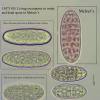
30-12-2025 16:44
Pascal DucosBonjour,Une anamorphe rose stipitée, très nombre

30-12-2025 17:14
 Bernard CLESSE
Bernard CLESSE
Bonjour à toutes et tous,Pourriez-vous aider Albe

29-12-2025 10:15
Hulda Caroline HolteHello, I found and collected this propoloid ascom

30-12-2025 09:04
Hello.A Pyrenomycete sprouting sparsely but very d

29-12-2025 17:44
Isabelle CharissouBonjour,J'aimerais savoir si d'autres personnes au

12-11-2021 00:03
Lepista ZacariasHi everybody,A week ago in my fiels trip I noticed

29-12-2025 17:12
 Bernard CLESSE
Bernard CLESSE
Bonjour à toutes et tous,Pourriez-vous m'aider à
Ostropalean fungus? Large, muriform spores
Jason Karakehian,
02-09-2017 17:18
Any hints for this fungus would be greatly appreciated. Asci 4-spored. Faint Melzer's+ reaction in subhymenium, flashing Melzer's+ reaction in epihymenium. Ascospores 44-57 x 25-33 um, hyaline but turning brown in Melzer's, muriform and fissured. Paraphyses filiform. On fallen, decorticated branch of unknown species. West Virginia, United States. Not sure if this is lichenized or not.
Thank you!
Hans-Otto Baral,
02-09-2017 20:50

Re : Ostropalean fungus? Large, muriform spores
Hi Jason
interesting collection! And yes, ostropalean. I think this needs testing Lugol (added to water mount, perhaps causing a rainbow of blue to red colours in the hymenium). Your statement of a flashing MLZ reaction might tell us that the hymenium is hemiamyloid but the chloralhydrate clears the iodine reaction within a few seconds because iodine diffuses faster than the chloral hydrate.
Are you sure that he brown colour of the spores is only a result of iodine and not a matter of melanin due to maturation? Does the brown colour totally disappear when you add KOH to the MLZ mount?
Zotto
interesting collection! And yes, ostropalean. I think this needs testing Lugol (added to water mount, perhaps causing a rainbow of blue to red colours in the hymenium). Your statement of a flashing MLZ reaction might tell us that the hymenium is hemiamyloid but the chloralhydrate clears the iodine reaction within a few seconds because iodine diffuses faster than the chloral hydrate.
Are you sure that he brown colour of the spores is only a result of iodine and not a matter of melanin due to maturation? Does the brown colour totally disappear when you add KOH to the MLZ mount?
Zotto
Jason Karakehian,
02-09-2017 22:35
Re : Ostropalean fungus? Large, muriform spores
Thank you Zotto.
I have done what you suggest using my slides that I saved. All of the photographs here are made from these 3 slides which I saved for later observations. You will note that in the crush mount showing spores that I had treated with Melzer's then rinsed with water and dried for storage, interestingly, the spores are now blue. I just now rehydrated them with water and took the photo that you see here, then added 3% KOH. They cleared as you suspected they would.
As for the ascospores, my initial photographs of them in water. These are from a separate slide that I prepared from ascospores ejected onto a coverslip from living apothecia, then mounted in water and observed. They were hyaline, and only turned brown after I added Melzer's. I did not retest this particular slide, but observed the dried spores and they are still brown. I don't know why the spores in my crush mount slide turned blue. Perhaps it was due to my rinsing the slide with water.
I then rehydrated my slides of my 15 um sections with water, then I added IKI. There was no reaction whatsoever. I'm not sure what to make of this as I describe my initial work on this with Melzer's had some fleeting reaction in the epithecium and a weak reaction in the subhymenium. Perhaps the material in my slides is tired!
I'm afraid these details may not be helpful but add confusion.
I look forward to learning more of your thoughts.
I have done what you suggest using my slides that I saved. All of the photographs here are made from these 3 slides which I saved for later observations. You will note that in the crush mount showing spores that I had treated with Melzer's then rinsed with water and dried for storage, interestingly, the spores are now blue. I just now rehydrated them with water and took the photo that you see here, then added 3% KOH. They cleared as you suspected they would.
As for the ascospores, my initial photographs of them in water. These are from a separate slide that I prepared from ascospores ejected onto a coverslip from living apothecia, then mounted in water and observed. They were hyaline, and only turned brown after I added Melzer's. I did not retest this particular slide, but observed the dried spores and they are still brown. I don't know why the spores in my crush mount slide turned blue. Perhaps it was due to my rinsing the slide with water.
I then rehydrated my slides of my 15 um sections with water, then I added IKI. There was no reaction whatsoever. I'm not sure what to make of this as I describe my initial work on this with Melzer's had some fleeting reaction in the epithecium and a weak reaction in the subhymenium. Perhaps the material in my slides is tired!
I'm afraid these details may not be helpful but add confusion.
I look forward to learning more of your thoughts.
Hans-Otto Baral,
02-09-2017 22:57

Re : Ostropalean fungus? Large, muriform spores
Thanks, this is very interesting. That the strong MLZ-reaction turns bluish when rinsed with water would sound strange for a dextrinoid reaction, although it should be dextrinoid. What you could still do is to add MLZ or Lugol to a KOH-pretreated section (after rinsing with water). Then we could fully be sure that there is no amyloidity of the asci and paraphyses, and know whether the spores still react the same deep brown.
In any case, the fungus has a lot of remarkable features. A new Cryptodiscus will be published soon which has 4-spored asci and muriform spores, but the spores are unchanged in iodine, the asci are hemiamyloid, and the ascomata are ellipsoid and orange.
In any case, the fungus has a lot of remarkable features. A new Cryptodiscus will be published soon which has 4-spored asci and muriform spores, but the spores are unchanged in iodine, the asci are hemiamyloid, and the ascomata are ellipsoid and orange.
Zdenek Palice,
02-09-2017 23:49
Re : Ostropalean fungus? Large, muriform spores
Hallo Jason (and Zotto), perhaps Ramonia could be considered as well, your specimen seems to form periphyses?. I am not able to see this from the pictures well, and also whether the exciple is formed of angular cells what would fit to Ramonia. In any case Ramonia nigra Coppins seems to be quite similar on the first view according to the original drawings, pictures, but still different (cf. Coppins 1987, Lichenologist 19(4): 411, Fig. 2 - C, E-F). That species should grow on wood of hollow trees or on spongy bark, and should have distinctly narrower ascospores, 8 per ascus. I know quite well only Ramonia luteola from the Carpathians, which is pale-fruited, mainly an old-growth forest species of humid mountain broad-leaved forests but also keep a specimen likely belonging to this taxon from shaded serpentinic rock outside humid woodland, but from an extreme shade. Zdenek
Zdenek Palice,
03-09-2017 00:15
Re : Ostropalean fungus? Large, muriform spores
Another option is Xerotrema, both described species have single-spored asci, but the overall habit is similar. Zdenek
see at
http://www.lichenology.info/pdf/HolienDiederichXerotrema.pdf
see at
http://www.lichenology.info/pdf/HolienDiederichXerotrema.pdf
Hans-Otto Baral,
03-09-2017 07:17

Re : Ostropalean fungus? Large, muriform spores
Such a Xerotrema I once studied. It has a rainbow (hemiamyloid) hymenium (asci blue after KOH), inamyloid spores, and a pale orange apothecium. Here the link:
https://invivoveritas.de/ascomycetes-illustrations/
go 6a Ostropomycetidae, here the last folder: Xerotrema
https://invivoveritas.de/ascomycetes-illustrations/
go 6a Ostropomycetidae, here the last folder: Xerotrema
Jason Karakehian,
03-09-2017 14:20
Re : Ostropalean fungus? Large, muriform spores
I will make new sections of an apothecium and test with these reagents again.
I think that I saw one of your notes on the Cryptodiscus with muriform spores in your Vivo Veritas material. I look forward to seeing the finished work.
I looked at Sherwood, 1987. My fungus keys out to Xerotrema in that, but the spores look very different from what you both have in your work. Also, in both of your photographs the apothecia have a dentate margin. I will see if there is Sherwood material of this in FH.
Also, the way the ascospores break up is very interesting. I wonder if this is a case of "endoascospores"? I am looking at a paper by G. Morgan-Jones. Endoascosporic cells in three pyrenocarpous lichen genera. Canadian Journal of Botany. 51:493-495. 1973. I will include this file here for reference.
Thank you both very much for your help and I will report back!
I think that I saw one of your notes on the Cryptodiscus with muriform spores in your Vivo Veritas material. I look forward to seeing the finished work.
I looked at Sherwood, 1987. My fungus keys out to Xerotrema in that, but the spores look very different from what you both have in your work. Also, in both of your photographs the apothecia have a dentate margin. I will see if there is Sherwood material of this in FH.
Also, the way the ascospores break up is very interesting. I wonder if this is a case of "endoascospores"? I am looking at a paper by G. Morgan-Jones. Endoascosporic cells in three pyrenocarpous lichen genera. Canadian Journal of Botany. 51:493-495. 1973. I will include this file here for reference.
Thank you both very much for your help and I will report back!
Hans-Otto Baral,
03-09-2017 16:22

Re : Ostropalean fungus? Large, muriform spores
Very interesting to see these endoascospores - I never heard of them and their liberation from septate ascospores although I know such thick-walled spores with endospore swellings and ocellate lumen quite well.
Jason Karakehian,
03-09-2017 17:40
Re : Ostropalean fungus? Large, muriform spores
I'm glad that you think so. It is very intriguing. You see a similar condition in living spores in Triblidium caliciforme. They seem to be spherical cells within the larger cells of an ascospore. In my observations of this, they didn't break apart like they do in our mystery fungus here, but I also didn't subject them to washings of KOH and extra pressure on the coverglass. I'm not too familiar with the genera that Morgan-Jones writes about, other than Trypethelium tropicorum, but it would be good to try to find them and see. I will attach a plate of T. caliciforme spores here. In two of the figures, you can see these spherical cells. I wonder if these are endoascospores.
Hans-Otto Baral,
03-09-2017 18:03

Re : Ostropalean fungus? Large, muriform spores
Indeed these are spores with thickened endospore. KOH seems to shrink the living spores and the cell lumina, but the wall seems unchanged. In other cases, e.g., Caloplacaceae, the endospore swells in dead spores and strongly alters the shape of the lumina.
The question is also whether spore cell separating effects by KOH and pressure have any correspondance in the natural life cycle or are only a distinguishing character.
The question is also whether spore cell separating effects by KOH and pressure have any correspondance in the natural life cycle or are only a distinguishing character.



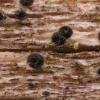

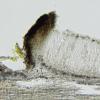
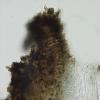
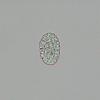

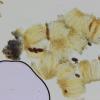

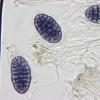
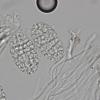
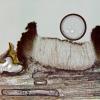


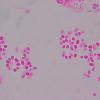
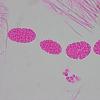
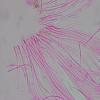
 Morgan-Jones.-1973.-Endoascosporic-cells-in-three-pyrenocarpous-lichen-genera.-Can.-Journ.-Bot.-51.-pp.-493-495-0001.pdf
Morgan-Jones.-1973.-Endoascosporic-cells-in-three-pyrenocarpous-lichen-genera.-Can.-Journ.-Bot.-51.-pp.-493-495-0001.pdf